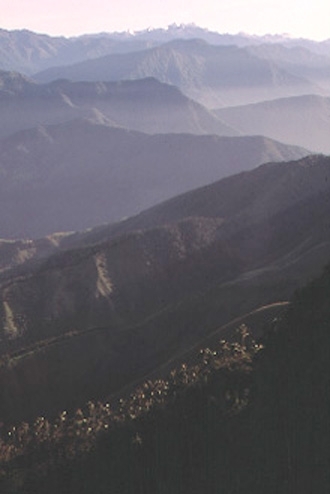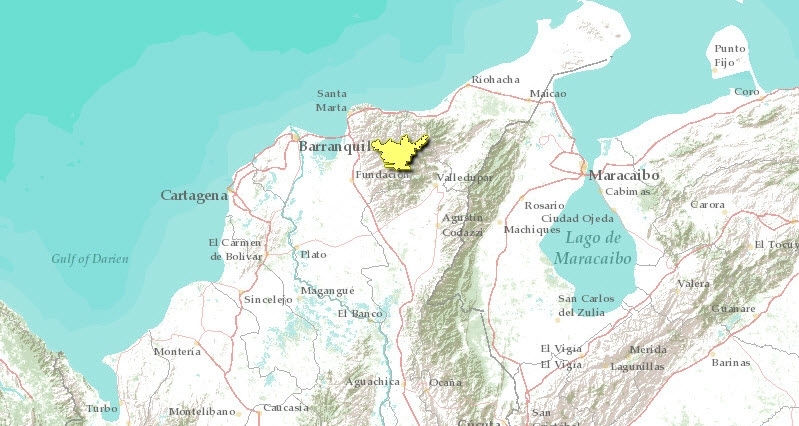Santa Marta páramo
This isolated ecoregion in Columbia is found in the Sierra Nevada de Santa Marta. Due to this isolation, a range of endemic flora and fauna occur here including the genus Cabreriela, Castenedia and Raouliopsis. This ecoregion is included in the jurisdiction of the Sierra Nevada de Santa Marta National Park, however existing cattle grazing and agricultural development by the indigenous people have severely altered the landscape.
Contents
Location and General Description
The southernmost areas of páramos high moors in South America (11° North Latitude) are found in the Sierra Nevada de Santa Marta, an isolated mountain system of the Andes range that rises to 5,775 meters (m) above sea level (m.a.s.l.) on the shores of the Caribbean in northern Colombia. This massif located between 10° 01'05 and 11° 20'11 north latitude and 72° 36'16 and 74° 12'49 west longitude, sits on a base of sub-triangular contours the northern edge of which runs parallel to the coastline. One edge looks to the west facing the Great Swamp de Santa Marta, while the other faces south-southwest to the Perijá mountains, from which it is separated by the valleys of the Cesar and Ranchería rivers.
The altitudinal range of this natural region has a lower limit below the level of the Andean forest and an upper limit below the permanent snow cap. It is characterized by the presence of short, shrubby or herbaceous vegetation that develops on climatically oligothermic land. Cleef & Rangel locate the strip of open páramo in the Sierra Nevada de Santa Marta between 3,300 and 5,000 m.a.s.l., with local variations depending on environmental factors such as precipitation, exposure, insolation, and gradient.
Geologically, nearly the entire area of the páramo consists of Jurassic gradodiorite. The climate is influenced by the northeast trade winds and by moist air currents that rise each day, producing mists and rains. Most of the rains occurs in the months of May and September, in keeping with the biomodal pattern characteristic of northern Colombia. Although there are few measurements, the estimated annual amount of rain for the páramo on the northwest side is less than 1,800 millimeters (mm) at 400 m.a.s.l. and average annual air temperature is 6° C.
Based on the peculiarities of how this mountain system rose, its astronomical location and orientation vis-à-vis the northwest trade winds, the páramo on the northern side is rugged and receives more rainfall than the páramo on the southern side located on lee side and protected from the trade winds and thus drier.
The biota is generally considered derived from hygrophilous tropical warm level stock as well as Andean elements that arrived through the eastern mountain range of Colombia in particular and others with more affinity to the Andes of Mérida and the mountain range on the Venezuelan coast. Phytogeographic analyses indicate that the flora on the páramo had their origins in elements at middle elevations that were created with the first orogenic uplift during the early and middle Cenozoic, subjected to a process of differentiation when they erupted in the new habitats of the high mountains generated by the final uplift of the la Sierra Nevada during the Pliocene and Pleistocene.
Variations in the physiognomy of the plant cover have fostered the recognition of substrips characteristic of the páramos. The lower limit of predominantly shrubby cover is called subpáramo with scrublands and woody species that grade into the Andean forest. The páramo sensu strictu has a predominance of scrublands and low shrubs and the superpáramo has grasses in cushions with scant coverage. To be noted in the transition between the upper limit of the forest and the open páramo are the scrublands of Calamagrostis effusa, intermixed with woody shrubs of Arcytophyllum nitidum, Stevia lucida, Escallonia myrtilloides, Hesperomeles lanuginosa. As open vegetation, possibly due to man-made causes, we find rosettes of Acaena cylindrostachya as well as Castilleja fissifolia, Lupinus carrikeri. Indigenous communities appear in the protected valleys and on the rocky slopes of the páramo environment; other shrubs present include Lachemilla polylepis, Simplocos nivalis, and Obtegomeria caerulescens.
In swampy areas and on the shores of glacial lakes there are cushions of Azorella crenata and rosettes of Hypochaeris sessiliflora while there are Callitriche nubigena and Ranunculus limoseloides under the water. In the superpáramo area, vegetation grows in patches, including Raouliopsis seifrizii, Draba sanctae-marthae and in areas more protected from the wind there are scrublands of Valeriana karstenii and rosettes of Perissocaelum purdiei.
To be noted among the fauna is the endemic venado de páramo (Mazana americana carrikeri), and the león colorado (Felis concolor bangsi). Birds include the Adean condor (Vultur gryphus), Rufous-collared sparrow (Zonotrichia capensis), Fuegian Snipe (Gallinago stricklandii), and frailejón (Libanothamnus glossophyllus).
Biodiversity Features
The existence of plant and animal endemisms, particularly in biomes in the middle and high [[mountain]s] were basic indicators for recognizing the singular nature of the Sierra Nevada de Santa Marta and establishing the status as of Biosphere Reserve in this biogeographic unit. The effective insularity of the region's páramos, separated from similar areas on nearby ranges, and the highly intense evolution of highland strains are considered decisive factors for the appearance of these endemisms.
Effective ecological isolation has fostered the process of differentiation and caused these páramos to become an important center of speciation that has given birth to plant genera such as Cabreriela, Castenedia, and Raouliopsis.
In the páramos of the Sierra Nevada, 135 genera of vascular plants have been counted; two of these are endemic, namely Raouliopsis Asteraceae and Obtegomeria Lamiaceae. Some genera with various endemic species grow only in the páramo environment. These include Pentacalia Asteraceae as 8 of its 11 endemic species grow only there and Diplostephium Asteraceae, as 9 of its 10 endemic species are found only in the páramo.
Other plant genera with species confined to the páramo environment are Micropleura, Niphogetum and Perissocaelum and Cotopaxia (Apiaceae). This latter plant with only a single species endemic to the páramo and another species in the high [[mountain]s] of central Ecuador, represents a biogeographic curiosity.
To date 125 species of angiosperms endemic to the Sierra Nevada have been counted. Of these 61 occur only in the páramo and 32 species belong to the family Asteraceae.
Current Status
The páramos of the Sierra Nevada are included in the jurisdiction of the Sierra Nevada de Santa Marta National Park, which was created in 1964 and now encompasses an area of approximately 383,000 hectares. It is also included in the Cogui-Arsario and Aruhaco indigenous refuges that have special jurisdiction over the territory. However, they are seriously affected by the existence of extensive cattle herds belonging to indigenous communities that reach up to 3800 m above sea level. A large part of the subpáramo or lower limit has been altered by burning to expand the scrublands and establish local potato and onion crops. Communities of small trees or shrubs are altered by extraction of wood for building and firewood, an activity associated with extensive burning on the páramo as such, to expand the scrubland, clearly degrading biological diversity, eliminating the cover of fallen leaves, reducing moisture retention, and promoting erosion on slopes. Cleef and Rangel note that the high coverage of Acaena cylindrostachya and Lupinus carrikeri in some sectors of scrubland seems to indicate a change in the original vegetation, as a result of extensive livestock, modifying the structure of the vegetation.
Types and Severity of Threats
With increased indigenous population there is greater pressure on the ecosystem, as more natural space is occupied that is vulnerable given the slow and difficult recovery of degraded areas. Pumas and condors are hunted to protect the indigenous peoples herds of cows and sheep.
The opening and degradation of the Andean forest expands the lower limit of the páramos, while the upper limit is opening up as the glaciers recede. In the paramos area there are many lakes of glacial origin that are the source of rivers like the Guatapurí, Donachuí, Fundación, Aracataca, Frio, Sevilla, Don Diego, Palomino, and Ancho from which rise the low and flat areas surrounding the Sierra. The stability of these reservoirs depends on the state of conservation of this region.
Justification of Ecoregion Delineation
This small páramo ecoregion is restricted to the summits of the Santa Marta [[mountain]s] of northern Colombia and are isolated from all other similar habitats. Initial linework follows UNESCO, which classifies this as "tropical Andean caespitose herbaceous closed to open community, with woody synusía of tuft plants (humid páramo)". Linework was later reviewed and modified by expert opinion at a priority setting workshop for ecoregion conservation.
Further Reading
- Carbonó, E. & Lozano-Contreras, G. 1997. Endemismos y otras singularidades de la Sierra Nevada de Santa Marta, Colombia. Posibles causas de origen y necesidad de conservarlos. Rev. Acad. Colomb. Cienc. 21(81): 409-419.
- Cleef, A.M, and O. Rangel-Churio. 1984. La vegetación del páramo nordeste de la Sierra Nevada de Santa Marta. En: Van Der Hammen and Ruíz editors, La sierra Nevada de Santa Marta (Colombia) Transecto Buritaca La Cumbre. Estudios de Ecosistemas Tropandinos. 2. J. Cramer. Berlin.
- Complejo Ecoregional de los Andes del Norte (CEAN). Experts and ecoregional priority setting workshop. Bogota, Colombia, 24-26, July, 2000.
- Cuatrecasas, J. 1961. Studies on Andean Compositae. V. Proc. Biol. Soc. Wash. 74: 7-28.
- Hernandez-Camacho, J. & Sanchez, H. 1992. Biomas terrestres de Colombia. En: Halfter (Comp.) La diversidad biológica de Iberoamérica I. Acta Zoológica Mexicana: 153-173.
- King, R. M. & Robinson, H. 1978. Studies in the Eupatorieae (Asteraceae) CLXXII. A new genus Castenedia. Phytología 39(1): 58-61.
- Monasterio, M. 1980. Los páramos andinos como región natural. Carácterísticas Biogeográficas generales y afinidades con otras regiones andinas. En: Estudios Ecológicos en los Páramos Andinos. Monasterio (Ed.): 16-27.
- Mora, L.E., and O. Rangel-Ch.. 1983. Una nueva Cyperaceae de la Sierra Nevada de Santa Marta (Colombia) y consideraciones fitogeográficas y sinecológicas sobre Carex. Rev. Acad. Colomb. Cienc. 15 (58): 13- 21.
- Perez- Preciado, A. 1984. Aspectos climáticos de la Sierra Nevada de Santa Marta. En: Van Der Hamme, and Ruíz, editors. La Sierra Nevada de Santa Marta (Colombia). Transecto Buritaca La cumbre. Estudios de Sistemas Tropandinos 2. J. Cramer. Berlin.
- UNESCO. 1980. Vegetation map of South America. Map 1:5,000,000. Institut de la Carte Internationale de Tapis Vegetal. Toulouse, France. ISBN: 9230998621
- Van Der Hammen, T. 1984. Datos Eco-climáticos del transecto Buritaca y alrededores. En: Van Der Hammen and Ruíz editorrs, La Sierra Nevada de santa Marta (Colombia). Transecto Buritaca La cumbre. Estudios de Sistemas Tropandinos 2. J. Cramer. Berlin.
- Wurdack, J.J. 1976. Endemic Melastomataceae of the Sierra Nevada de Santa Marta, Colombia. Brittonia 28: 138-143.
| Disclaimer: This article is taken wholly from, or contains information that was originally published by, the World Wildlife Fund. Topic editors and authors for the Encyclopedia of Earth may have edited its content or added new information. The use of information from the World Wildlife Fund should not be construed as support for or endorsement by that organization for any new information added by EoE personnel, or for any editing of the original content. |

